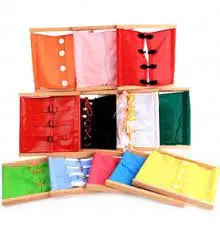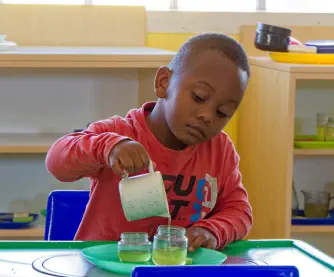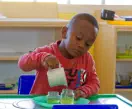NEDBANK NAMIBIA · ACCOUNT NO. 11990522989 · BRANCH CODE 461-038 · SWIFT CODE NEDSNANX

The Practical Life area is a cornerstone that not only defines a Montessori classroom,
it fulfills the child’s inner plea of
“Help me to do it myself!”
This section of the classroom is almost like a mini museum that exhibits the many aspects of real life to a child.
Dr.
Maria
Montessori’s
keen
observations
of
children
led
to
a
discovery
of
this
profound
philosophy:
That
education
must
be
an
aid
to
life.
And
if
education
is
an
aid
to
life,
then
the
curriculum
should
also
satisfy
the
developmental needs of children.
Practical
Life
exercises
are
essential
because
they
solve
a
developmental
need
of
the
child:
Promoting
functional
independence
from
a
young
age.
This
area
of
the
classroom
adapts
to
the
actual
life
of
a
child
by
simulating
a
comforting
home
environment
that
bridges
the
child
from
the
house
to
the
classroom.
They
feature
engaging
activities
that
help
children
learn
to
be
independent
and
care
for
both
themselves
and
their
environment.
Children
discover
how
to
use
a
mop
or
a
broom
to
clean
the
floors
of
the
classroom
they
live
in.
They
acquire
the
art
of
setting
up
for
snack
or
lunch,
plating
their
meals
on
actual,
child-sized,
breakable
tableware
and
drinking
water
from
a
glass
cup.
They
take
pride
and
interest
in
learning
how
to
dress
themselves
as
they
become
experts
of
the
button
and
zipper
frames.
Practical
Life
is
not
only
fun
to
a
child,
it
is
also
useful
from
a
physical
development
perspective
—
refining
both
gross
and
fine
motor
skills
through
movements
that
are
vital
for
any
growing
child.
Each
activity
enhances
physical
coordination
and
promotes
muscle
development.
In
our
Children’s
House
classrooms,
Practical
Life
exercises
enable
our
children
to
interact
with
real-world
objects.
They
learn
to
master
the
use
of
spoons,
tongs,
juicers,
mops,
brooms
and
other
objects
they
will
encounter
for
the
rest
of
their
lives.
The
sense
of
accomplishment
in
completing
these
exercises
also
boost
any
child’s
confidence
tremendously
as
they
slowly realize,
“I did it all by myself! I can actually do it!”


NEDBANK NAMIBIA · ACCOUNT NO. 11990522989 · BRANCH CODE 461-038 · SWIFT CODE NEDSNANX

The Practical Life area is a cornerstone that not only defines a Montessori classroom,
it fulfills the child’s inner plea of
“Help me to do it myself!”
This section of the classroom is almost like a mini museum that exhibits the many aspects of real life to a child.
Dr.
Maria
Montessori’s
keen
observations
of
children
led
to
a
discovery
of
this
profound
philosophy:
That
education
must
be
an
aid
to
life.
And
if
education
is
an
aid
to
life,
then
the
curriculum
should
also
satisfy
the
developmental needs of children.
Practical
Life
exercises
are
essential
because
they
solve
a
developmental
need
of
the
child:
Promoting
functional
independence
from
a
young
age.
This
area
of
the
classroom
adapts
to
the
actual
life
of
a
child
by
simulating
a
comforting
home
environment
that
bridges
the
child
from
the
house
to
the
classroom.
They
feature
engaging
activities
that
help
children
learn
to
be
independent
and
care
for
both
themselves
and
their
environment.
Children
discover
how
to
use
a
mop
or
a
broom
to
clean
the
floors
of
the
classroom
they
live
in.
They
acquire
the
art
of
setting
up
for
snack
or
lunch,
plating
their
meals
on
actual,
child-sized,
breakable
tableware
and
drinking
water
from
a
glass
cup.
They
take
pride
and
interest
in
learning
how
to
dress
themselves
as
they
become
experts
of
the
button
and
zipper
frames.
Practical
Life
is
not
only
fun
to
a
child,
it
is
also
useful
from
a
physical
development
perspective
—
refining
both
gross
and
fine
motor
skills
through
movements
that
are
vital
for
any
growing
child.
Each
activity
enhances
physical
coordination
and
promotes
muscle
development.
In
our
Children’s
House
classrooms,
Practical
Life
exercises
enable
our
children
to
interact
with
real-world
objects.
They
learn
to
master
the
use
of
spoons,
tongs,
juicers,
mops,
brooms
and
other
objects
they
will
encounter
for
the
rest
of
their
lives.
The
sense
of
accomplishment
in
completing
these
exercises
also
boost
any
child’s
confidence
tremendously
as
they slowly realize,
“I did it all by myself! I can actually do it!”































